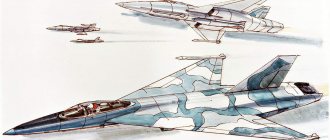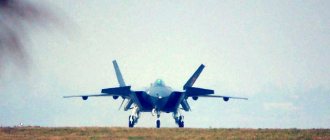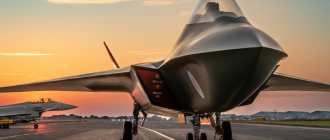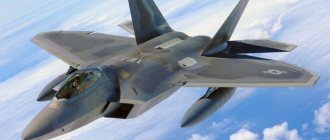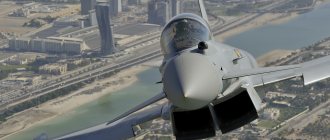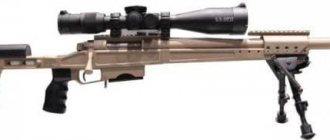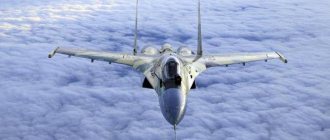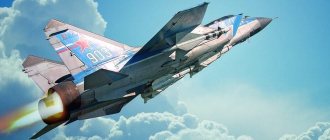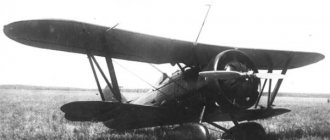In September, US Air Force Acquisition Assistant Secretary Will Roper said the Pentagon had secretly designed, built and flown at least once a prototype X-plane under the Next Generation Air Dominance (NGAD) program. The latter means, in particular, a new generation unmanned or manned aircraft, including a sixth generation fighter. Lenta.ru talks about what the purchasing assistant meant.
“In the real world, we have already built and flown a full-scale flight demonstrator, and we have broken all records in this matter. We are ready to start building the next generation of aircraft like never before,” an acquisition assistant told Defense News.
Roper noted that the development of the X-plane involved not just the use of agile development methodology, open architecture and digital engineering, as was the case with the US-Swedish eT-7 Red Hawk jet trainer, but something more. “We are committed to the most complex systems ever created and have tested all the capabilities of this digital technology. In fact, [we] demonstrated something truly magical,” the purchasing assistant added.
eT-7 Red Hawk trainer aircraft
Photo:
Roper refused to name the number of X-plane prototypes built, its design features, purpose, combat characteristics, in particular, speed and control mode (with or without a pilot), as well as the lead developer of the product and the place where the first flight took place. However, the acquisition assistant said the test was important because it demonstrated the Air Force's ability to use advanced technology to test digitally engineered products.
Ready production
Judging by such statements, the American industry is really ready to produce new fighters. According to Roper, the NGAD product line can be rolled out "fairly quickly," but the Air Force must first determine the exact number and timing of its X-plane procurement, which could affect the five-year defense budget expected to begin in FY 2022. in the context of the current COVID-19 pandemic, the Pentagon believes, leaves much to be desired.
NGAD, on which about a billion dollars will be spent in fiscal year 2022, could, on the one hand, radically “shake up” the US defense industry, and, on the other hand, jeopardize the planned volumes of military equipment purchases. It is believed that the NGAD program may involve, in addition to traditional Pentagon contractors, new companies, in particular, even SpaceX, which are able to offer competitive prices for their own products, and advanced development methods used, for example, in the eT-7 Red Hawk program, will reduce the cost of programs like the F-15 Eagle by ten percent over their 30-year life cycle.
Fifth generation fighter F-35 Lightning II
Photo: Globallookpress.com
Popular Mechanics notes that NGAD "ends up in an overflowing shopping cart." The publication recalls that over the next ten years, the Air Force plans to purchase, develop or modernize the F-35 Lightning II, F-15EX Advanced Eagle, B-21 Raider heavy strategic bomber, eT-7 Red Hawk, KC- tanker aircraft. 46 Pegasus and the intercontinental ballistic missile of the Ground Based Strategic Deterrent (GBSD) project. “How is the Air Force going to pay for everything?” - the publication asks, suggesting that NGAD "will come out on top of this list."
Defense One, in a publication dedicated to Roper's statement, writes that "the new aircraft may not be the product of one of the defense giants" like Boeing, Northrop Grumman or Lockheed Martin. The publication recalls that in July, 18 applications were submitted to the Air Force competition, which involves the creation of unmanned aerial vehicles for manned aircraft. “There is evidence that the digital design tools Roper touted are allowing smaller upstarts to enter markets that were once reserved only for certain contractors,” Defense One writes.
The plane under which there is no war
In Russia, work is underway on a sixth generation fighter. As in the USA, China, Great Britain, Europe. But these aircraft will have qualities for which a suitable war is not yet in sight...
“Work on the sixth generation is already underway,” RIA Novosti quotes the words of Sergei Khokhlov, General Director of the State Research Institute of Aviation Systems (GosNIIAS).
Sergei Khokhlov. Photo: MOD Russia, Vadim Nekrasov/Globallookpress
But then Khokhlov said something strange:
The main difference from the fifth generation will be that in the basic version, the sixth generation fighter is supposed to be unmanned. Piloting capability is optional. All other characteristics are a further development of existing ones: even faster, even more maneuverable, even more inconspicuous, and so on...
What's strange?
There are two of them. Since we are talking about the optional presence of a person in the cabin of the car, then make drones! They will certainly cost less than a device with a complex and expensive life support system for a living person. And there is huge scope for development “faster, more maneuverable, more inconspicuous.” Because the fifth generation of fighters is already flying at conditions that are close to the limit for humans - both in terms of reaction speed, and in terms of overloads, and in the ability to control dozens of rapidly changing parameters with one brain. And so designers are already starting to talk about machines with artificial intelligence. It is not yet as developed as the human one, but the electronic, and soon the quantum, thinking apparatus is much more reliable than a clot of neural mucus that turns off even with a strong blow. Not to mention the emotions that interfere with making quick and correct decisions.
So the person is needed FOR THE TIME. AI has not yet developed to the stage of confident data analysis and decision-making, and aircraft have not yet reached the level of missiles that maneuver with overloads of up to 20g (and in the West they boast that the new German-European IRIS-T missile can withstand 60g). And then everything - hello, the era of combat terminators, where a person is needed only to evoke pity from a robot. And then - one managed to summon, but the second, more developed one, only managed to melt...
IRIS-T rocket. Photo: Daniel Karmann/Globallookpress
The second strange thing is that “faster, higher, stronger” is not yet a new generation, just as a runner who ran a hundred meters in 9.69 seconds is not at all a product of the next generation than one who ran in 9.91. Perhaps a new generation of doping...
The new generation is not evolutionary, but leap-level improvements in the basic performance characteristics. Let's say hypersonic speed. Or absolute invisibility. Or a radar looking right into the cockpit of someone else’s plane. Will it be?
New features of the new leap
According to the radar, by the way, 6th generation equipment seems to be emerging. We are talking about the so-called radio-photonic complexes, which Constantinople spoke about not so long ago. An interesting thing, but it just ruins the principle of radar stealth!
However, this principle was, to put it mildly, not absolute from the very beginning. It made it difficult to track the aircraft, but did not completely prohibit it. And, it turns out, for the sixth generation it is necessary to invent in this sense something like a spatial cocoon, which waves of any radiation flow around. Yes, we know that work in this direction is underway, but this is still a vague fantasy.
So what is this – a sixth generation aircraft? To understand this, the easiest way is to go through the pages of Western magazines on military topics. They also don’t give away secrets, but at least they allow you to guess about trends. Not like our comrade. Khokhlov...
Trends for 6th generation: 0
Work on aircraft of the next generation after the 5th is actively being carried out in all technically developed countries - in Russia, the USA, England, China, Germany, France. But it still seems that this work consists for now only of an active search for the concept of machines of the future.
Thus, there is almost complete agreement that only hypersonic speed opens the door to the 6th generation. And on this point, the closest thing to the “checkpoint” where the pass will need to be presented is Russia with its work on the MiG-41 interceptor fighter that has reached very promising levels.
It is believed that precisely due to this speed, the ESR will, in a certain sense, decrease - in other words, its visibility on screens. After all, to ensure such speed, the car will need to be assembled from composite materials, and they are poorly reflected on radars. If he can hide a hypersonic missile from the Kinzhal complex inside the fuselage, then in terms of “speed-invisibility-lethality” this aircraft will be able to claim a place at the 6th stage of aviation generations.
In the United States, another trend is developing, which belongs to the next stage of development. According to the Next Generation Air Dominance (NGAD) program, the next generation of fighter aircraft should be “networked.” That is, a certain - let's call it a “swarm” - conglomerate of different machines works as one whole, with some carrying some kind of perfect weapon, some electronic warfare equipment, someone will become a container for artificial intelligence and will act as the commander of this entire flock.
A full-size model of a new generation fighter jet is displayed during the 53rd Paris Air Show in Paris, France, June 20, 2022. Photo: Xinhua/Globallookpress
Something similar to how modern anti-ship missiles behave today: they fly at the victim with the whole gun at once, replacing each other in the role of leader when it is shot down, aiming at its target-probing rays. But with airplanes this will really be at the level of the next generation.
The aircraft themselves, so to speak, personally must, as is implied, have the following characteristics. For the Air Force, a fighter of the Penetrating Counter Air (FX/PCA) program, designed to gain air superiority, escort bombers and independently combat ground targets (the same tasks as the Su-57), must be able to fly far, carry many missiles and be invisible to radar. As you can see, there is also nothing conceptually outstanding compared to the same Su-57, which represents the 5th generation.
The sixth generation “concepts” of other aircraft manufacturing companies and other countries are in approximately the same spirit. Everyone is talking about the best, but not the revolutionary best characteristics. Except that almost everyone promises an airplane in the guise of a “flying wing”.
Su-57. Photo: Photo: MOD Russia/Globallookpress
Britain has generally been criticized by experts for... immodesty. More precisely, for the “immodest desire” to pass off his Tempest project, which is actually a 5th generation fighter, and, moreover, not yet ready, as a 6th generation fighter. And only on the basis that it can fly in... an unmanned version. So Comrade Khokhlov is not alone...
The Chinese also shared plans to create a 6th generation fighter. Only in Chinese: without actually saying anything. But in China they have already built a wind tunnel weighing 6,620 tons and having a volume of 17,000 cubic meters for these developments. Apparently they also intend to test the “flying wing”.
So what do we see? And we see almost an international “conspiracy” - in quotes, of course - of aviation designers who are “selling” to their governments the concepts of 6th generation aircraft, which in fact are suitable for no more than a 5+ or maximum 5++ badge. And for some reason they are massively emphasizing unmanned control as the main sign of a leap into the next stage of development. And only one Russian MiG-41 is close to having at least two or three properties of a truly revolutionary new machine. But this is also not the 6th generation.
But what should it be like to truly become revolutionary?
The next material is about this.
Competition and innovation
Roper's surprise announcement likely stems from the Air Force's hopes of securing adequate budget funding, especially amid the uncertainty caused by COVID-19. However, it makes sense to draw economic rather than military conclusions from it. As has been repeatedly stated, the current US development and production of new stealth fighters, strategic bombers and wing drones is less a revolutionary innovation and more a high-tech routine. And, despite the presence of a limited number of large military-industrial companies, competitive conditions are still created in the United States for the emergence of new players in the market capable of offering the Pentagon non-standard but effective solutions.
Probably, American competitors could pay attention to the fact that the relatively low cost of the new NGAD program drones (based on their life cycle), the management of which involves the active use of artificial intelligence systems, indirectly indicates their increased lethality. On the other hand, according to Roper, continued development and production of fighter jets will provide the United States with a strategic advantage by placing countries such as China and Russia in a state of technological uncertainty regarding the actual American military capabilities.
Is everything okay, beautiful marquises?
The current state of US combat aviation presents a rather contradictory picture. On the one hand, this is a huge armada, far outnumbering all potential opponents. Thus, according to FlightGlobal, the US military has 13,232 aircraft and helicopters of all types - not only more than anyone else, but also approximately equal to the sum of the next six places in the top ten most aviation-equipped countries.
However, this is a rather crafty figure that does not provide complete peace of mind to the American military-political leadership. In many ways, it is determined by the huge number of helicopters (which, of course, is also important and useful, but is beyond the scope of today’s topic), but in terms of combat aircraft, Russia and China already have a combined numerical superiority.
One should not discount the fact that American power is “smeared” across almost the entire globe. This global presence is ensured by a huge fleet of refueling aircraft (625 or ¾ of all available in the world), which, of course, contributes to the overall size of the air force and its mobility, but is not always capable of helping in combat. The result is that locally - for example, in the Western Pacific region - Americans will likely find themselves in the minority compared to China. The situation for the United States is partly improved by its allies, but one cannot completely rely on them.
However, when the United States itself proclaimed the era of “confrontation between the great powers” (Great-Power Competition, mandatory today for any American doctrinal document), what was much more sensitive was not the lack of quantitative superiority, but the unreliability of qualitative superiority.
In the early 2020s, the main fighter of the US Air Force remains the workhorse F-16, the last of which was received in 2005, and most were released in the 1990s. Modernization programs are ongoing, but limited, and American F-16s are inferior in combat capabilities to those exported over the past ten years.
In the navy, the fleet of combat aircraft is practically unified: everyone (even tankers) is supported by the same faithful “workhorse” F/A-18E/F - a worthy representative of the 4+ generation, but in no way superior to potential opponents - the Su-35 or J-16. Meanwhile, it is precisely qualitative superiority—on a level, on a generation—that the American military demands. Meanwhile, the national military-historical myth insists that America has always (at least after World War II) provided its pilots - of course, the best in the world - with equipment superior to that of their opponents. In myth it cannot be otherwise. But this makes the real current situation completely unacceptable.
By the way, the situation with pilots is also contradictory. On the one hand, American aviation has been almost continuously involved in combat operations for thirty years - for example, in 1991-2003 there were daily so-called patrols of no-fly zones over Iraq, during which hundreds of thousands of flights were carried out and hundreds of strikes on ground targets. However, these were all low-intensity conflicts in which aviation operated, at best, against primitive and small ground-based air defenses. The last full-fledged battle with a full-fledged and at least technically close enemy was given to the Americans by the Iraqis just thirty years ago.
Of course, Russian and especially Chinese pilots did not have such experience over the same period of time. But, on the other hand, in combat training they could afford to concentrate on the fight against a serious enemy, and not exhaust their personnel with months-long business trips and routinely bombard the next enemies of the free world with adjustable aerial bombs.
Generation Conflict
The issue of generations of winged aircraft is debatable; there is often no clear line between them.
The fifth generation, which has managed to set the teeth on edge, is characterized, first of all, by stealth, supersonic cruising speed and super-maneuverability, as well as integration into a unified information and command system. But no matter how advanced fifth-generation aviation systems are, they have one weak link: humans. It is believed that the combat potential of a fighter today is hampered by the limitations of the human body and mind. That is why there is reason to argue that sixth-generation cars can become completely unmanned and will be capable of speed and maneuverability that designers of past years never dreamed of.
Artists' fantasies on the theme of sixth generation fighters / ©flightglobal.com
However, this seemingly obvious thesis is only partly true. The fact is that neither enormous speed nor outstanding maneuverability can save aircraft from anti-aircraft missiles. Over the past decades, air defense systems have made a big leap forward, and now almost the only salvation from them is stealth.
On the other hand, the use of stealth technologies often leads to a deterioration in flight characteristics, and always to a sharp increase in the cost of the aircraft. The price difference is especially noticeable for unmanned systems. For example, the RQ-4 Global Hawk reconnaissance UAV costs $140 million, while promising American devices built using stealth technology will cost several times more. Therefore, the question of whether the sixth generation fighter will be unmanned largely lies in the economic plane.
According to leading experts, such an aircraft should exist in both manned and unmanned versions, and the manned version can be used as a leader for a small flight, including several unmanned vehicles. But why turn a fighter into a drone control center? Isn’t it easier to do it from the ground? The problem is that UAVs have not yet become fully autonomous, and sending signals from several thousand kilometers away means delays. In modern air combat, where everything is decided by fractions of seconds, such a delay is like death. In addition, in a serious conflict, both sides will actively use all kinds of jammers: at such moments it is better to stay close to their drones.
Artists' fantasies on the theme of sixth generation fighters / ©flightglobal.com
It is believed that the appearance of the next generation of combat vehicles will be very different from the previous ones: even more inconspicuous, they should gain even greater flight capabilities. If fifth-generation vehicles can perform complex maneuvers at subsonic speeds, then the sixth generation should do this already at supersonic speed, and in afterburner gain hypersonic speed (exceeding Mach 5 - about 6 thousand km/h).
Otherwise, sixth-generation cars will not be fundamentally different from the fifth or fourth generation, with two pluses. They will learn to interact even more widely with land or sea units. The weapons will become even more long-range, which will make it possible to operate hundreds of kilometers from the affected area of enemy anti-aircraft missile systems. The gigantic price of combat vehicles will not allow the creation of highly specialized aircraft; fighters will only expand their versatility by learning to use the entire range of existing weapons.
The sixth generation will not soon supplant the fifth. Even generation four plus fighters will serve for many more decades, and aircraft such as the PAK FA will remain in service until the 2050s. The modernization potential of modern fighters is very great, and sixth-generation technologies will first find their application on machines of the previous generation.
Perhaps laser weapons will be added to the usual adjustable bombs and missiles. Thus, the US Air Force plans to equip the sixth generation with several types of laser systems. Low-power – for disabling enemy sensors, medium-power – for destroying missiles. Finally, powerful lasers will have to hit enemy aircraft and disable ground equipment. But to seriously talk about this, we need to solve the issue with the power source, increase the power and reduce the price of laser systems.
In order to maintain stealth, all sixth-generation weapons will be placed inside the fuselage, similar to how it is done on fifth-generation vehicles.
Sixth generation fighter project F/A-XX / ©flightglobal.com
What do we know
First of all, to create a full-fledged sixth-generation fighter, it is necessary to develop an appropriate power plant. And the creation of a new aircraft engine takes up to two decades (which is by no means the limit). Especially when we are talking about a fundamentally new unit.
In principle, the Americans are conducting research into the creation of an experimental power plant operating on hydrogen-oxygen steam. Essentially, these are two installations in one, with one of them “working” in the atmosphere, and the other in near space, at suborbital altitude.
The most interesting thing is that the Russian Igla project is more than a decade ahead of its American counterpart in this area. As is known, the United States does not have alloys capable of withstanding the temperature of the combustion chamber of a hydrogen engine. They also don’t have the appropriate materials for the power plant blades. American intelligence has repeatedly tried to buy up the formulas for the corresponding substances in Russia, but, thank God, so far to no avail.
© Photo from the archive
Model of the hypersonic aircraft "Igla".
In the field of development of artificial intelligence for the 6th generation fighter, the Russian side knows that tests of the “full-size demonstrator” prototype showed insufficient controllability of the American aircraft and failure during climb maneuvers. Also, some commands from the remote operator console were not executed.
Is it possible to move to the VI generation in Russia?
The Russian Su-57 is an open architecture aircraft. In other words, it is modular and allows the creation of new innovative modifications, which, for example, is impossible for the American F-22. In addition, the Su-57 is also unpretentious during combat operation, that is, it is capable of showing results even in harsh conditions close to combat ones.
In this regard, we can conclude that the current Su-57 already contains the ability to be upgraded to the sixth generation level.
© sukhoi.org
The Su-57 is unpretentious during combat operation and is capable of showing results even in harsh conditions close to combat ones.
As for drones (remember that the United States intends to make the sixth generation in two modifications at once - with and without a pilot), Russia has already tested drones that, with the help of artificial intelligence, remotely controlled a nearby Su-57 in the air . Note that, unlike the Americans, the Russian side does not hide where and what exactly was tested. That is, you don’t need to take your word for it in this case - there is always the opportunity to double-check.
In conclusion, we can say that, of course, “magic” in the spirit of Will Roper is probably good, but for adults it is somehow ... unreliable.
But Russian aircraft - unlike American "Pepelats" - can be touched and felt, and their commercial price, as a rule, is much cheaper than their Western counterparts, although our aircraft often have more advanced technologies.
